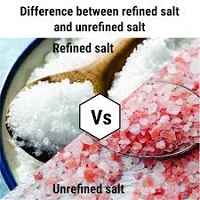Refined Versus Unrefined Salt: Is There Any Difference?
Refined versus Unrefined Salt – on my food blogging journey, I learned that a lot of us find it difficult to understand that there are different types of salts.
Therefore, in this post, we will be about salt and the difference between refined salt and unrefined salt.

Table of Contents
Refined Versus Unrefined Salt: What Kind Of Salt Do You Use?
Kosher salt? Sea salt? Table salt? Pickling salt? However, isn’t salt, salt? Is there any difference? Yes, there is, read on to find out.
Specially for You >>> Flavor Enhancer: Ogiri Okpei, Nigerian Seasoning Flavor
What Is Salt?
According to Wikipedia, salt is a mineral composed primarily of sodium chloride (NaCl), a chemical compound belonging to the larger class of salts,

Salt in its natural form as a crystalline mineral is known as rock salt or halite. Salt is present in vast quantities in seawater, where it is the main mineral constituent.
It is gotten from salt mines (ancient dried ocean beds) or evaporated ocean water and is a basic food ingredient.
Despite the dozens of different salt on the store shelf, there are mainly two kinds of salt: unrefined or refined.
Refined Salt
How is salt refined? Most salt has been harvested by using a machine from various salt mines as brine.
Brine is a high-concentration solution of salt (NaCl) in water (H2O). Before mechanical evaporation, the brine is often treated with chemicals to remove minerals (which are later sold to industries).
Below are the basic steps in salt refining:
- Salt feeding
- Salt washing & milling (using sulfuric acid and/or chlorine)
- Dosing of additives & coating
- Salt drying
- Sizing and conditioning
Refined salt comes out very pure, about 99.5% pure NaCl and without any minerals.
The “dosing of additives” can include anti-caking agents (potassium or sodium ferrocyanide), calcium silicate, free-flowing agents (magnesium carbonate, sodium silico-aluminate, and tricalcium phosphate).
Also, iodizing agents (potassium iodide or iodate with dextrose, aka sugar, to stabilize the iodide)
Unrefined Salt
Salt in its natural form is known as unrefined salt. It is not treated or altered by man. Hence, it contains many different minerals and elements that are useful for the body.
As a basic ingredient in culinary use, unrefined salt also has a distinctive flavor and adds great taste to the different kinds of dishes.
Then again, unrefined salt can be found to contain a whole display of colors.
Pink Himalayan, Red Alaea, Black lava, Persian Blue, and French Grey salt, to name but a few. The color of the salt is determinant on where it has been harvested.
There are a few brands of unrefined salt that contain different amount of trace minerals reliant on their origin namely:
Real salt, Redmond’s real salt, unrefined sea salt, Celtic sea salt, pink Himalayan, and real salt.
For instance, Celtic Sea Salt contains over 80 minerals and elements-all the natural elements needed for life, unlike refined salt which contains two major items: sodium and chloride.
Refined versus Unrefined Salt: Why is Salt Refined?
You may be asking yourself the above question. Salt is refined for four main reasons:
Companies selling salt believe that all white salt looks cleaner and attractive to the consumer thereby increasing sales. Refined salt is often bleached to look whiter.
Refined salt is essentially a lifeless product having all of its minerals removed. Hence, it guarantees a longer shelf life since it can sit on the shelf forever without spoiling. Therefore, it is advantageous for food manufacturers.
The refining process removes all toxins especially if the salt is taken from a polluted area.
Iodine is added to refined salt to prevent swelling of the thyroid (goiter). However, there is not enough iodine in salt that can prevent thyroid illness.
Refined versus Unrefined Salt: Is There Any Difference?
There is a huge difference between refined and unrefined salt.
- Unrefined salt has not been put through various machines to remove the minerals and other elements that are naturally part of the salt.
- Unrefined salt is packed with essential minerals and supplies the body with a proper balance of sodium and chloride with over 80 trace minerals.
- Besides, unrefined salt has not been exposed to harsh chemicals.
- Finally, unrefined salt will have the minerals and elements associated with its origin.
- Refined salt, on the other hand, is a poor food choice. It provides the body with too much sodium. Sodium is meant to be ingested with its complement of trace minerals.
- The consequences of the ingestion of large amounts of refined salt are mineral deficiencies, acidity, and the onset of chronic illness.
- Another problem with this heavily ground salt is it can clump together. For this reason, anti-caking agents are added.
Summary
Refined salt has no minerals in it and is not good for health, while unrefined salt is loaded with minerals.
It is not rocket science to realize that unrefined salt will be better to promote a healthy pH.
Thus, unrefined salt should be the salt of choice because this is a healthier salt choice, as compared to refined Table (processed) Salt.
Is Salt Good or Bad?
Salt has been shunned by many organizations, including the American Heart Association.
This is understandable when referring to the processed and iodized table salt because of the side effects.
But what about the natural sea salt and other natural salts such as Himalayan pink salt or Hawaiian volcano salt.



Pingback: How to Make Best Aromatherapy Bath Salts At Home - 9jafoods